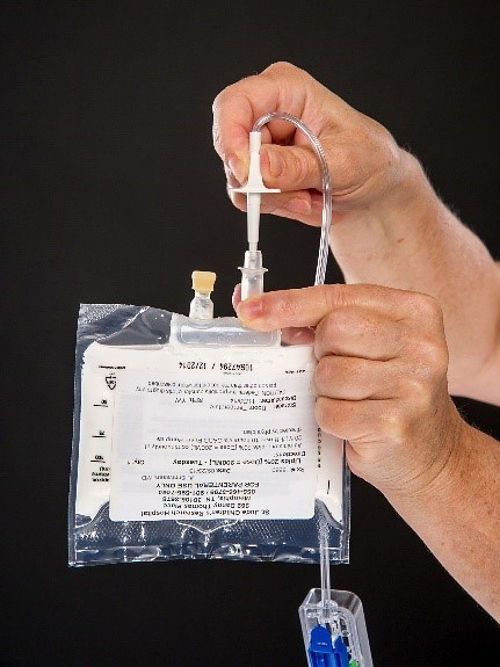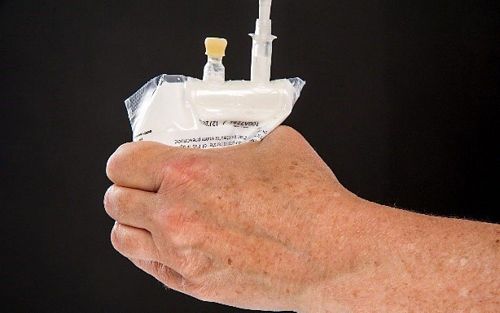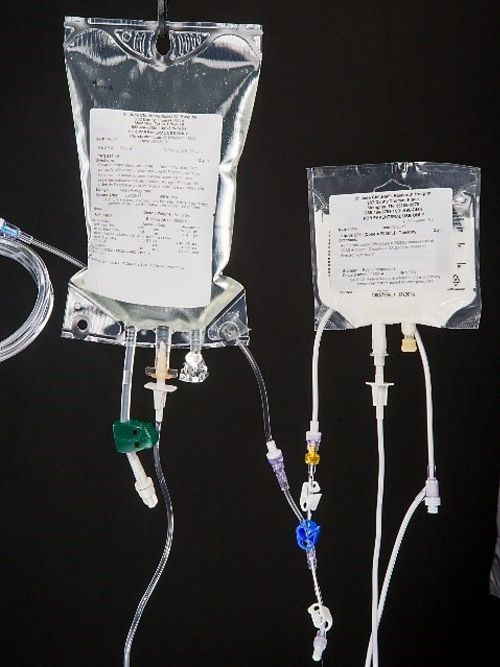Menu
Close
Back
Welcome to
Together is a new resource for anyone affected by pediatric cancer - patients and their parents, family members, and friends.
Learn MoreYou are giving TPN (total parenteral nutrition) at home until your child can eat regular meals. Lipids are another source of calories to increase or maintain your child’s weight. Your doctor has ordered lipids added to your child’s TPN infusion.
A separate CADD pump may be used to give the lipids. This pump will be connected to your child’s TPN pump using a Y connector. This allows the TPN and lipids to infuse at the same time through one lumen (tube) of your child’s central venous line.
The same service that delivers your child’s TPN will deliver the lipids. Store the lipids at room temperature.
Preparing the lipids is another step in the process you have already learned for preparing your child’s TPN.
You will follow the same steps for preparing the work space and washing hands as you were taught for giving TPN.

Remove the blue cap and spike down into the bag.
1. Lipids are prepackaged in a plastic wrapper. The pharmacy label for your child’s lipids will be stapled to the plastic wrapper. Open the wrapper and remove the bag of lipids. Apply the pharmacy label to the lipid bag. Having the label on the bag is important in case of an emergency so that medical personnel would know what the doctor ordered.
2. Prepare your child’s TPN bag as instructed. Open the Y connector and clean one connector with a Site Scrub or alcohol pad.
3. Attach the IV tubing to the clean connector. Prime the tubing as instructed for TPN.
4. Open the IV tubing and clean the other connector on the Y connector with a Site Scrub or alcohol pad.
5. Then, attach the IV tubing to that side of the Y connector.
6. Turn the lipid bag upside down so all the air rises to the top. Remove the blue cap and spike down into the bag (photo 1).

Squeeze air from the bag.
7. Squeeze all the air from the bag (photo 2).
8. After the air is squeezed out, turn the bag over and allow the tubing to prime by gravity.
9. When priming is complete (the tubing is full of liquid), close the clamp on the IV tubing.
10. The CADD pump will be in continuous mode—CON on the screen—for lipid infusion. Review the program to make sure the volume and rate match the label the pharmacy provided.
11. Attach the cassette to the pump.
12. After both, TPN and lipid infusions are prepared and all tubes are primed, change the connector as you have been taught and flush your child’s line with saline.
13. Then, connect the end of the Y connector to the new connector on your child’s line (photo 3).

Connect the end of the Y connector to the new connector on your child’s line.
14. Start the TPN infusion first and then start the lipid infusion.
15. Check to be sure you have opened all of the clamps on the IV tubing, the Y connector, and your child’s line.
16. When the lipid infusion is finished, clamp the line on the lipid side of the Y connector and remove the lipid tubing from the Y connector.
17. Wash your hands and grab another Site Scrub and the disinfectant cap.
18. Clean the connector on the Y connector with a Site Scrub, and put the disinfectant cap on it. You do not need to flush with saline at this time.
19. There still might be fluid in the lipid bag. Throw away any leftover fluid along with the tubing in the regular trash.
—
Reviewed: September 2022